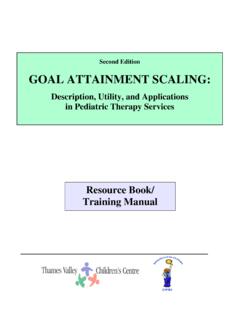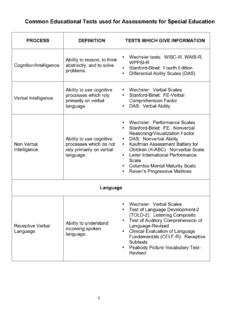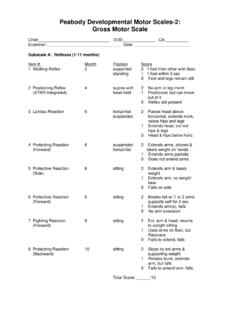Transcription of Test Descriptions and Report outlines - HomeSpeechHome
1 1 Test Descriptions and Report outlines Apraxia tests Kaufman Speech Praxis Test for Children (KSPT) Screening Test for developmental Apraxia of Speech Articulation tests Clinical Assessment of Articulation and Phonology (CAAP) Contextual Probes of Articulation Competence (CPAC) Fisher-Logemann Test of Articulation Competence Goldman Fristoe Test of Articulation-2 (GFTA-2) McDonald-Deep Test of Articulation Photo Articulation Test-Third Edition (PAT-3) Weiss Comprehensive Articulation Test (WCAT) Autism Spectrum tests Autism Behavior Checklist (ABC) Childhood Autism Rating scale (CARS) Evaluating Acquired Skills in Communication (EASIC) Gilliam Autism Rating scale (GARS) Examination of the Oral Speech Mechanism Fluency tests Stuttering Prediction Instrument Stuttering Severity Instrument-third edition (SSI-3) Stuttering Severity scale Language tests - Comprehensive Clinical Evaluation of Language Fundamentals-4 (CELF-4) Comprehensive Assessment of Spoken Language (CASL) Fullerton Language Test for Adolescents-second edition Functional Communication Profile Oral-Written Language scale (OWLS) Oral-Written Language scale -2 (OWLS-2) Test of Adolescent and Adult Language-third edition (TOAL-3) Test of Language Development-Intermediate: third edition (TOLD-I:3) Test of Language Development-Primary: third edition (TOLD-P.)
2 3) Language tests - Expressive The Test of Narrative Language (TNL) The Expressive Language Test (ELT) The HELP Test- Elementary Patterened Elicitation Syntax Test (PEST) Structured Photographic Expressive Language Test-third edition (SPELT-3) 2 Test for Examining Expressive Morphology (TEEM) The WORD Test - Adolescent The WORD Test - Elementary Language tests - Receptive Language Processing Test -Revised (LPT-R) The Listening Test Rhode Island Test of Language Structure (RITLS) Test of Auditory Comprehension of Language-third edition (TACL-3) Token Test for Children Language tests - Preschool Clinical Evaluation of Language Fundamentals-Preschool (CELF-pre) Receptive-Expressive Emergent Language Test-third edition (REEL-3) Rossetti Infant-Toddler Language scale Preschool Language Assessment Instrument (PLAI) Preschool Language scale -4 (PLS-4) Structured Photographic Expressive Language Test-Preschool (SPELT-P) Test of Early Language Development-Second Edition (TELD-2) Language tests - Other Boehm Test of Basic Concepts-Revised (BTBC-R) Bracken Basic Concepts scale -Revised (BBCS-R) Elementary Test of Problem Solving -Revised (TOPS-Elementary-R) Language Sample Nonspeech Test for Receptive and Expressive Language Test of Problem Solving-Adolescent (TOPS-Adolescent) Test of Pragmatic Language (TOPL) Language tests - Vocabulary Assessing Semantic Skills through Everyday Themes (ASSET) Carolina Picture Vocabulary Test for Deaf and Hearing Impaired (CPVT) Comprehensive Receptive and Expressive Vocabulary Test-second edition (CREVT-2) Expressive One-Word Picture Vocabulary Test (EOWPVT) Expressive One-Word Picture Vocabulary Test-Upper Extension (EOWPVT-UE) Expressive Vocabulary Test (EVT)
3 Peabody Picture Vocabulary Test-III (PPVT-III) Receptive One-Word Picture Vocabulary Test (ROWPVT) Phonology tests Assessment Link between Phonology and Articulation (ALPHA) Assessment of Phonological Processes-Revised (APP-R) Comprehensive Test of Phonological Processing (CTOPP) The Hodson Assessment of Phonological Patterns-third edition (HAPP-3) Khan-Lewis Phonological Analysis-2 (KLPA-2) 3 Spanish Assessments Assessment of Phonological Processes, Spanish (APP -Sp) Austin Spanish Articulation Test (Austin) Bilingual Syntax Measure, I or II (BSM, I or II) Bilingual Vocabulary Assessment Measure (BVAM) Boehm Test of Basic Concepts-Revised, Spanish (BTBC-R-SP) Bracken Basic Concepts scale -Revised -Spanish (BBCS-R-Sp) Clinical Evaluation of Language Fundamentals-3, Spanish (CELF-3-SP) Del Rio Language Screening Test (DRLST) Dos Amigos Verbal Language Scales Expressive One-Word Picture Vocabulary Test-Upper Extension-Revised, Spanish Expressive One-Word Picture Vocabulary Test-Revised, Spanish Expressive One-Word Picture Vocabulary Test-Upper Extension, 2000-Spanish Expressive One-Word Picture Vocabulary Test-2000, Spanish Language Assessment scale (LAS) Medida Espa ola de Articulaci n (MEDA) Multicultural Vocabulary Test (MVT) Preschool Language Assessment Instrument-Spanish (PLAI-Sp) (Prueba Para El Diagnostico del Lenguaje Pre-Escolar) Preschool Language scale -3, Spanish (PLS-3, Sp) Pruebas de Expresi n Oral y Percepci n de La Lenguaje Espa ola (PEOPLE).
4 Prueba del Desarrollo Inicial del Lenguaje (PDIL) Receptive One-Word Picture Vocabulary Test, Revised--Spanish (ROWPVT-R-Sp) Receptive One-Word Picture Vocabulary Test Upper Extension, Revised-Spanish (ROWPVT-UE-Sp) Screening Test of Spanish Grammar (STSG) Spanish Articulation Measure (SAM) Spanish Expressive Vocabulary Test (SEVT) Spanish Language Assessment Procedures: A Communication Skills Inventory (SLAP) Spanish Structured Photographic Expressive Language Test-Preschool (SPELT-P-Sp) Spanish Structured Photographic Expressive Language Test-II (SPELT-II-Sp) Spanish Test for Assessing Morphologic Production (STAMP) Test de Vocabulario de Im genes, Peabody (TVIP) Toronto Test of Receptive Vocabulary (TTRV) Listing of ENGLISH tests WHICH MAY BE USED WITH SPANISH-SPEAKING CHILDREN 4 Apraxia tests The Kaufman Speech Praxis Test for Children (KSPT) is a norm-referenced, standardized assessment of a child's speech production to assist in identifying and determining treatment options for children with developmental dyspraxia of speech.
5 developmental dyspraxia of speech is the inability to plan, coordinate and produce non-habitual oral movements necessary to produce syllables and words. The test is presented in four parts of increasing difficulty and administration is dependent on the individual's level of functioning. Each part is norm-referenced and generates a standard score where 100 is mean and 85-115 being the range of average. Test parts Standard Score Part 1: Oral Movement Part 2: Simple Part 3: Complex Part 4: Spontaneous Length 's standard score on Part of is considered . The Screening Test for developmental Apraxia of Speech was given to screen the need for more specific speech and neurological evaluation. obtained a weighted score of . This can be interpreted as . Articulation tests The Clinical Assessment of Articulation and Phonology (CAAP) is a norm-referenced instrument designed to assess English articulation and phonology in preschool and school-age children.
6 It provides two types of standard scores that measure articulation competence. These are a Consonant Inventory Score (CI) and a School Age Sentence Score (SAS) both of which have a mean of 100 and 85-115 as the range of average. In addition, phonological processes are analyzed for percentage of occurrence. 's CI standard score of is considered . 's SAS standard score of is considered . A review of s consonant inventory and consonant singleton index indicate that . An analysis of s productions on the Phonological Process Checklists indiate the following processes to be active (greater than 40% occurrence): 5 The Contextual Probes of Articulation Competence (CPAC) portion of the Secord Contextual Articulation tests (S-CAT) is a measure of a student's ability to produce target phonemes in a variety of phonetic contexts.
7 The CPAC probes for the phoneme were targeted as these were the typical error patterns noted during the evaluation/therapy session. Each probe targets single words, words in clusters/phrases and sentences. 's responses are judged correct or incorrect and a percentage of accuracy determined, similar to tasks done in therapy sessions. 's percentages are listed below: target phoneme % in words % in clusters % in sentences The Fisher-Logemann Test of Articulation Competence is a measure of a student s spontaneous articulation of consonant, vowels and diphthongs. s errors are listed below by word position with error/target. Initial position of words: Medial position of words: Final position of words: Blends: The Goldman Fristoe Test of Articulation-2 (GFTA-2) is designed to provide a systematic means of assessing an individual's articulation in single words.
8 Descriptive information about the individual's articulation skills is obtained through three subtests: Sound-in-words, Sound-in-syllables, and Stimulability. 's errors are listed below with error sound followed by target sound: Initial position of words: Medial position of words: Final position of words: Blends: According to responses to the McDonald-Deep Test of Articulation, the phoneme was produced correctly in the following facilitative contexts: 6 The Photo Articulation Test-Third Edition (PAT-3) is a measure of a student s spontaneous articulation of consonant, vowels and diphthongs. s errors are listed below by word position with error/target. Initial position of words: Medial position of words: Final position of words: Blends: The Weiss Comprehensive Articulation Test (WCAT) is a measure of a student's ability to articulate the sounds of English in single words and sentences.
9 Was asked to complete sentences during which target phonemes were evaluated for correct or incorrect production. 's errors are listed below by word position with error/target. Initial position of words: Medial position of words: Final position of words: Blends: Autism Spectrum tests Autism Behavior Checklist (ABC) This checklist is 1 of 4 subtests intended to serve as a behavioral screening tool for indicators of autism. There are scaled scores for each item, with a score of 4 being a higher indicator than a score of 1. The mean total score for autism is 77, with a score of 67 or higher serving as a high indicator. ABC Indicator Scaled Score Sensory Relating Body & Object Use Language Social & Self Help Test Total Autism score cut-off = 67 The Childhood Autism Rating scale (CARS) is a fifteen-item behavioral rating scale developed to assist in the identification of children with autism, and to distinguish them from developmentally handicapped children without the autism syndrome.
10 It further differentiates children with autism in the mild, moderate, and severe range. The CARS is rated on a 1-4 point basis for each of the fifteen items, with 1 being the least predictive and 4 being the most predictive of autism with a cut-off score of 37 total points. 7 The CARS was rated by . The following numbers were assigned to each of the 15 items: Relating to People: Imitation: Emotional response: Body use: Object use: Adaptation to change: Visual Response: Listening Response: Taste, smell, and touch response and use: Fear or nervousness: Verbal Communication: Activity level: Level and consistency of intellectual response: General impressions: Total Score: According to the score the CARS rating is: The Evaluating Acquired Skills in Communication (EASIC) is a communication skills inventory in five levels.






